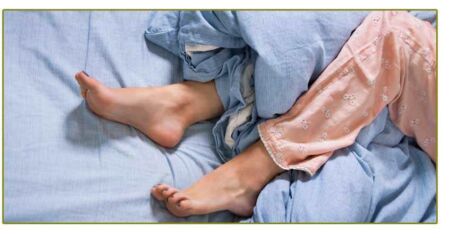
Restless legs syndrome (RLS) is a condition in which your legs feel extremely uncomfortable, typically in the evenings while you're sitting or lying down. It makes you feel like getting up and moving around. RLS can begin at any age and generally worsens as you age. Restless legs syndrome can disrupt sleep — leading to daytime drowsiness — and make traveling difficult. Moving the legs reduces and may relieve the discomfort. The constant need to move the legs disturbs sleep and can lead to impairment of function in daily life.
The condition was first suggested to be associated with venous insufficiency Dr. Karl A Ekbom in 1944. Doctors who treat varicose veins have long heard from their patients descriptions of throbbing, buzzing, creepy-crawly, pains in the lower extremities--symptoms that sound very similar to those of RLS. Restless legs syndrome has long been accepted as a symptom of venous insufficiency by phlebologists. When RLS co-exists with venous insufficiency, treating the venous insufficiency can provide substantial improvement in symptoms and subsequently the quality of life.
Restless legs syndrome affects approximately 10 percent of adults in the United States. RLS may begin at any age, including childhood, and affects approximately twice as many women as men. 80% of those affected by RLS also experience Periodic Limb Movement Disorder (PLMD) during sleep, in which the patient has brief "jerks" of the legs or arms while sleeping.
PLMD causes you to involuntarily flex and extend your legs while sleeping — without being aware you're doing it. Hundreds of these twitching or kicking movements may occur throughout the night. If you have severe RLS, these involuntary kicking movements may also occur while you're awake. PLMD is common in older adults; 4 out of 5 people with RLS also experience PLMD.
Venous insufficiency not only causes varicose veins, it can be the underlying cause for a multiple conditions, including lower extremity cellulitis, leg cramps and restless legs syndrome. When patients present with venous insufficiency symptoms, physicians often only check some of the obvious explanations and do not delve deeper to look for the possibility of venous reflux as an underlying cause. Unfortunately, there is a large percentage of people walking around with venous problems who aren’t getting the evaluation or treatment they need. Symptoms of restless legs syndrome may vary from person to person but often include burning, tingling, creeping sensations and the uncontrollable urge to move the legs. This is generally worse at night when laying down and is usually relieved by movement or walking. The symptoms of venous insufficiency and restless leg syndrome are almost interchangeable and many patients with documented severe superficial venous insufficiency and restless leg syndrome will have resolution of their restless leg syndrome after successful vein treatment.
Studies show that the treatment of venous insufficiency can relieve symptoms of restless leg syndrome. According to a study in the journal Phlebology, in patients with restless leg syndrome and venous insufficiency, 98% of patients experienced relief from restless legs syndrome symptoms by treating their venous insufficiency, and 80% had long-term relief.
Given the results of the recent studies, it is recommended that, before patients start taking prescription medication for restless leg syndrome, they request a consult by a qualified vein specialist who can perform ultrasound evaluation to identify whether there is significant underlying venous insufficiency which may be causing or contributing to their problem. There is no downside to getting an ultrasound - there is no radiation involved, no needles, no pain, and it is a physiologic test which reveals which veins are leaking and how much they are leaking. Venous ultrasound for insufficiency is conservative, noninvasive, and it accurately identifies which patients are most likely to benefit from treatment.